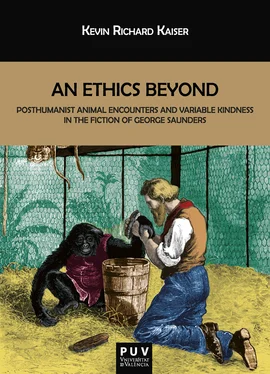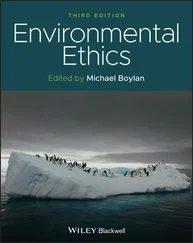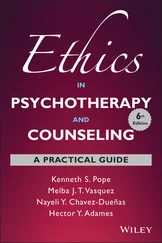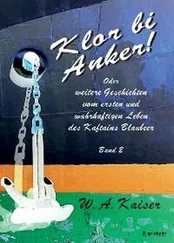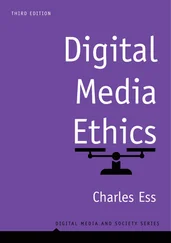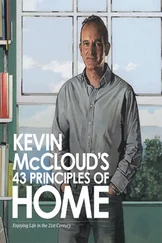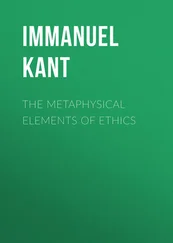Saunders’s reading of Slaughterhouse-Five leads him to eventually realize that its seemingly absurdist elements are necessary, since “our most profound experiences may require this artistic uncoupling from the actual” (79, italics original). Becoming “unstuck” in time and being held captive by aliens become necessary events for leaving the reader altered by the experience of reading Slaughterhouse-Five . Regarding the novel, Saunders argues that Vonnegut “wrote as if there were a continuum of consciousness between himself and the Terrible Event” because he never claimed that it had excused him from the expected “obligations of being kind, attempting to understand, behaving decently. On the contrary, Vonnegut seemed to feel that unkindness […] had been the cause of his Terrible Event, and that what he had learned from this experience was […] the importance of preserving kindness in ourselves at all costs” (77). The Terrible Event was Vonnegut’s experience during World War II, when, as a captive of the Nazis, he survived the Allied bombing of Dresden by hiding inside the meat locker of the slaughterhouse where he was imprisoned. The experience seems to shape the ethics of the novel, which Saunders notes, perhaps because they resonate with his own ethical concerns. When Saunders first read Slaughterhouse-Five , he was struck by the absence of detail, the lack of realism. Only later did he realize that the goal of Vonnegut’s novel was “to soften the heart, to encourage our capacity for pity and sorrow” (79). This is also what Saunders’s writing essentially does. Both the satire and the absurd encourage our capacity for kindness and compassion.
In the essay “The Perfect Gerbil: Reading Barthelme’s ‘The School’,” Saunders describes the rising action of Barthelme’s story, in which the postmodern writer breaks an established pattern—everything that comes into the school dies—while continuing to escalate the plot. According to Saunders, Barthelme “has gotten tired of being polite” so that “[w]ithout worrying about whether it’s allowed, whether it will be understood, or is logical within the world of the story […] he races off in the direction his logic is taking him […] trying to get the story to answer the questions the thing’s been asking all along; What are we to make of death? How are we to live in a world where death is king?” (182). This break in the pattern allows Barthelme to deal with an otherwise sensitive subject.
Barthelme is aware of the game: for the sake of the plot, the action must rise. This is achieved by establishing a pattern, yet this pattern cannot go on indefinitely; once the reader catches on, to insist on continuing the pattern makes the reader feel insulted. Barthelme uses humor in a way that makes it seem as if the story is winking and nudging its reader. The pattern of death is funny, yet the story’s humor is in the service of something else, namely, forcing us to confront death. Eventually the narrator tells us of deaths outside the school, but the point at which the story really takes a twist is when the students begin asking where all the dead have gone. Suddenly, the story is not just about a bunch of dead plants and animals but about the meaning of life. Then the students ask if the narrator will make love with Helen, a character who until this point in the story has gone unmentioned. A story about death becomes also a love story. Of course, when the narrator and Helen begin to be intimate there is a knock at the door—like a knock-knock joke—and a gerbil enters the room. Since we know the pattern, we can assume the gerbil will not live a long life. The absurdist moment here helps us to confront life, love, and death in a final single paragraph. This is not postmodern irony for irony’s sake but an emotionally charged moment that challenges us, ethically, to consider what is important to us in life. Life feels as brief as Barthelme’s story demonstrates, and love may be all we have time to share. Like Barthelme’s story, Saunders’s writing is compassionate because of its dark humor; the absurd elements in his—and Barthelme’s, Vonnegut’s, and Twain’s—stories are not so absurd when considered as necessary elements to affect an emotional response from the reader. Yet, while Saunders may be the most prominent living author writing this type of emotionally-charged ethical satire, he is not the only one.
“America 101”: Peers, Influences, and David Foster Wallace
As easily as Saunders can be compared to his forebears, he also can be compared to certain contemporary American or America-based authors who have achieved prominence on account of their “sincere” writing, achieved either through satire or experimentation with form. Saunders’s writing embodies both. Like Jonathan Franzen and Gary Shteyngart, he is a satirist. Like Jennifer Egan and Junot Díaz, he experiments with form. What sets his work apart is that he creates worlds more than borrows from them. His fiction may reference pop culture, but just as often he creates his own cultures. By distancing his stories from a fully recognizable world through the use of his idiolect, Saunders helps the reader become deeply aware of the sociocultural and linguistic idiosyncrasies of contemporary American culture. Richard Lee describes these worlds as “close enough in their zeitgeist to our own—the occasional dystopic setting or futuristic context notwithstanding that reviewers’ comments since his first collection routinely acknowledge” Saunders as a satirist (2010, 83). He is a “consciously ironic voice who plays with notions of the real and the fictive, a writer who easily ironies the writing situation at both macro- and micro-levels: cultural critique at the large scale, consciousness and perception at the narrative scale” (2010, 83). The worldbuilding found in Saunders’s writing occasionally takes its cues from genre fiction, especially speculative fiction, in a way reminiscent of Jonathan Lethem’s early novels or of Michael Chabon’s later writing, yet Saunders also often draws from lived experience. In the second part of an interview with Patrick Dacey published in BOMB , Saunders describes his life while reading Hemingway, an author he admired but found impossible to emulate:
Living in Amarillo, Texas, working as a groundsman at an apartment complex, with strippers for pals […], goofball drunks recently laid off from the nuclear plant accosting me at night when I played in our comical country band, a certain quality of West Texas lunatic-speak I was hearing, full of way off-base dreams and aspirations—I just couldn’t hear that American in Hem-speak. (2017, n.p.)
Saunders’s jobs have informed his writing. After graduating from the Colorado School of Mines and working as a geophysicist, he also worked as a doorman, roofer, convenience store clerk, slaughterhouse knuckle puller, and pharmaceutical company report writer. 6In an interview with Jana Hoops, Saunders describes his work experience as forming a chapter of his life during which he studied “America 101” and discovered “what our country—and capitalism—are really like, face-to-face” (Dacey n.p.).
Saunders is a constant reader and has been inspired by many writers, especially short fiction authors. He admires the Russian masters of short stories and novellas: Isaac Babel, Anton Chekhov, and Leo Tolstoy. American authors have influenced his writing directly as well. Tobias Wolff, regarded for his short fiction, was his teacher at the MFA program in Creative Writing at Syracuse. Saunders’s satire, as I have mentioned, is in the vein of Twain and Vonnegut. However, his style and tone belong to the present. Among North American authors, for example, his style bears similarities to that found especially in Margaret Atwood’s dystopian trilogy: Oryx & Crake (2003), The Year of the Flood (2009), and MaddAddam (2013). 7Among contemporary American authors, he is praised by Tobias Wolff, Thomas Pynchon, Jay McInerney, and Colson Whitehead. Preeminent among those who have praised him, however, and the writer whose mission is closest to the heart of Saunders’s writing, is the late David Foster Wallace. 8In an article for The New York Times Magazine , Joel Lovell reminisces about his years at Harper’s Magazine , recalling that around the time of the book launch for the novel Infinite Jest (1996), Wallace was “standing in the hall in his untied high-tops, saying that George Saunders was the most exciting writer in America” (2013, n.p.). This comment came from the author who would, upon publishing Infinite Jest , become the most exciting writer in America.
Читать дальше
